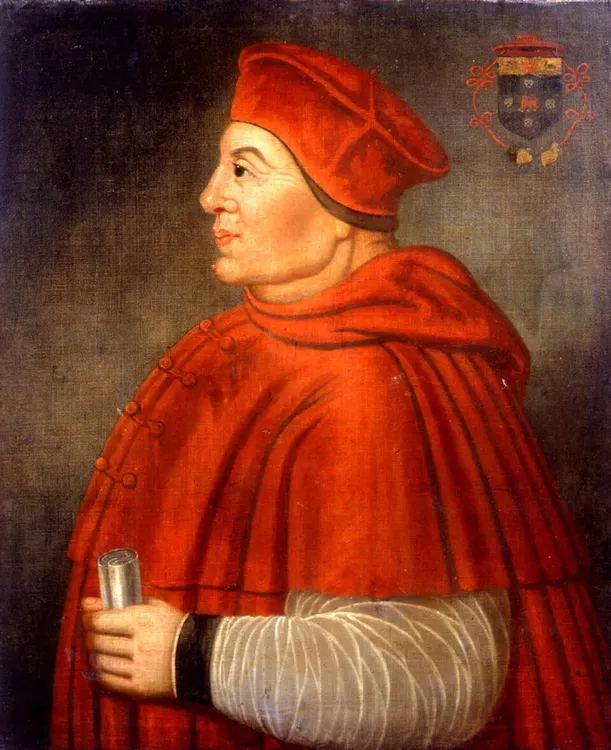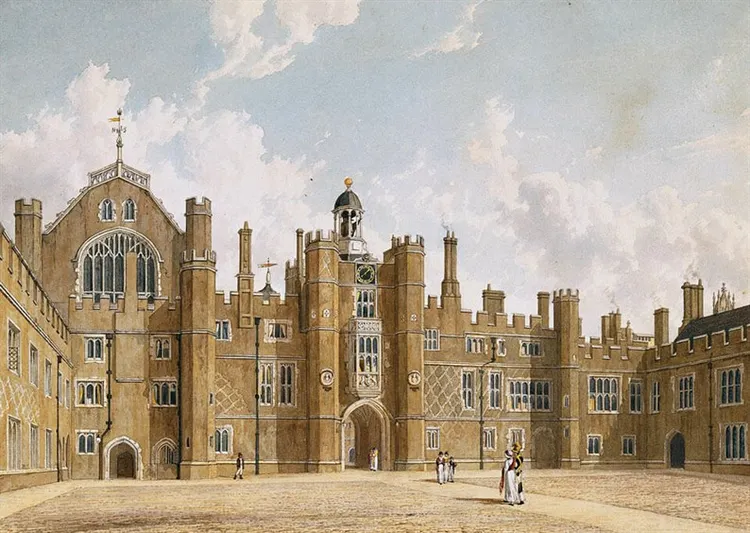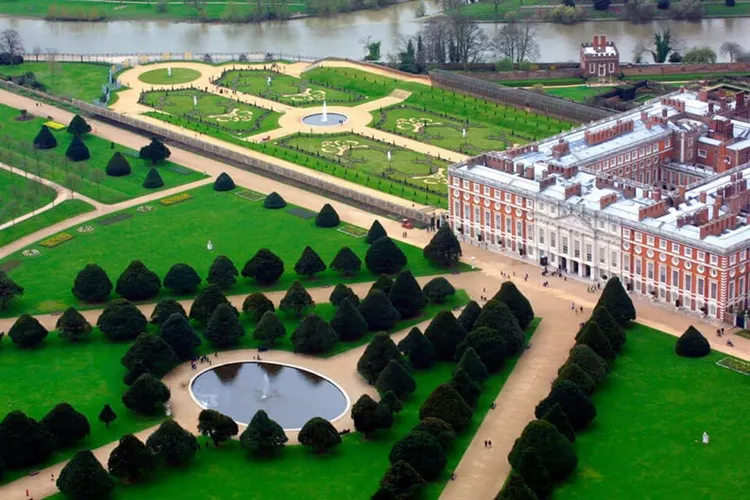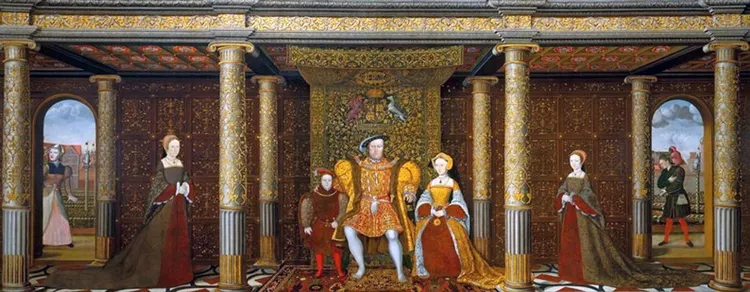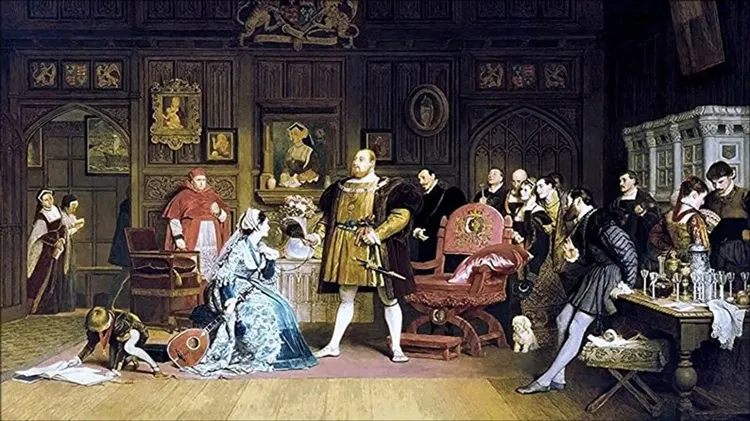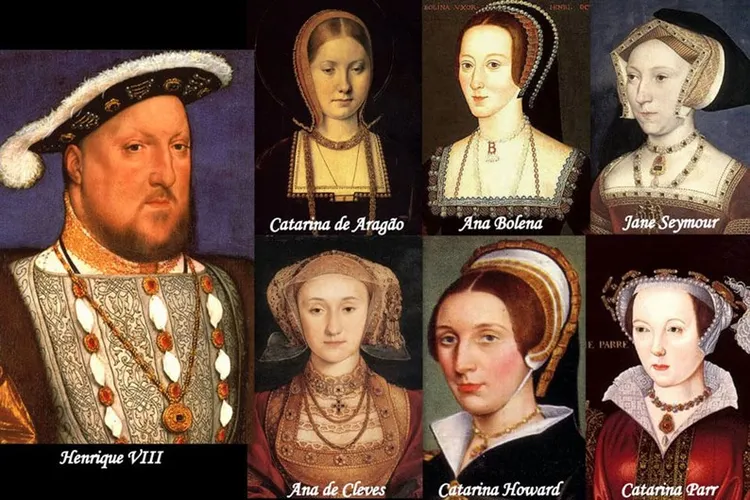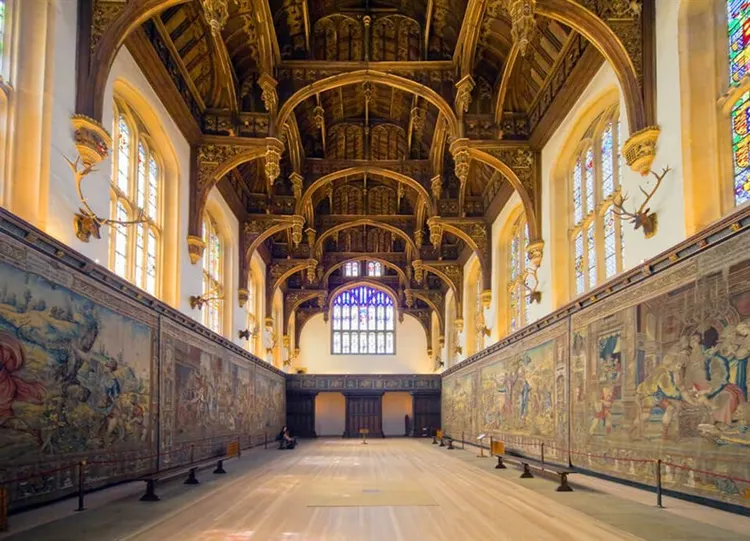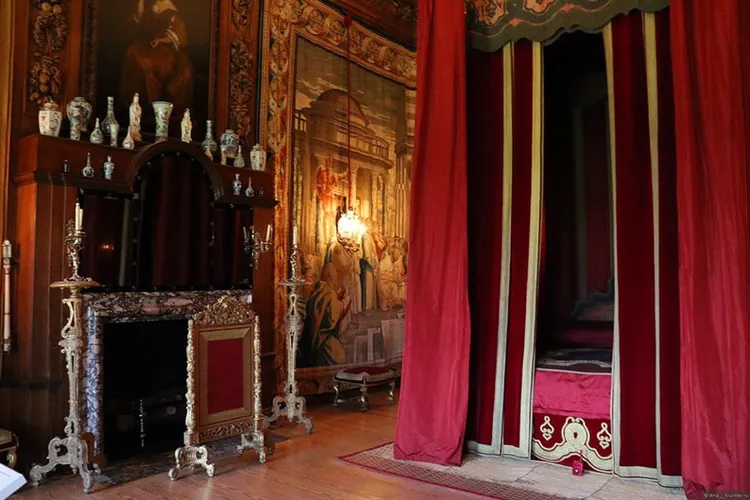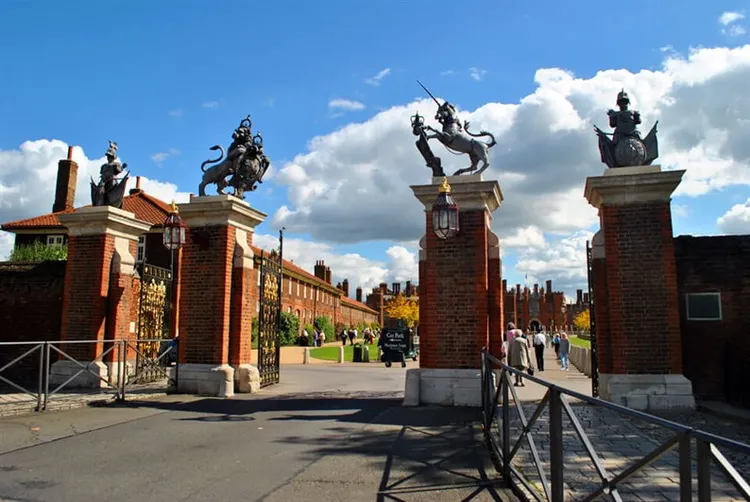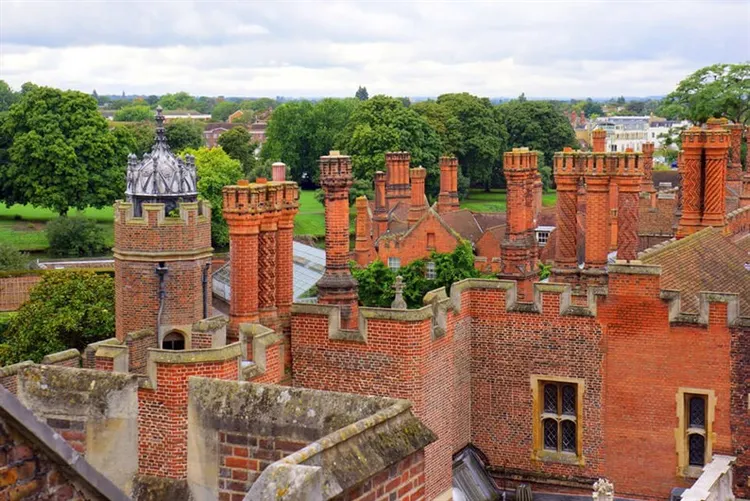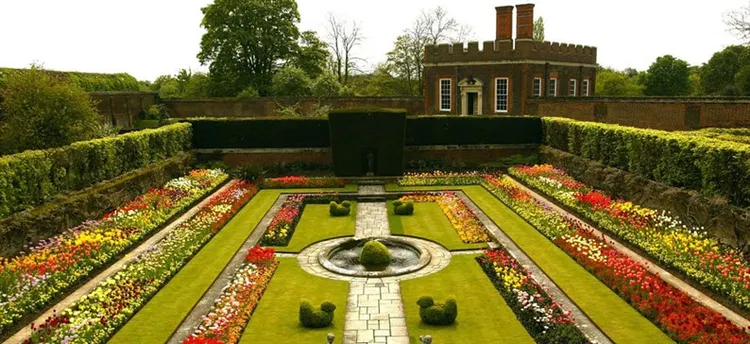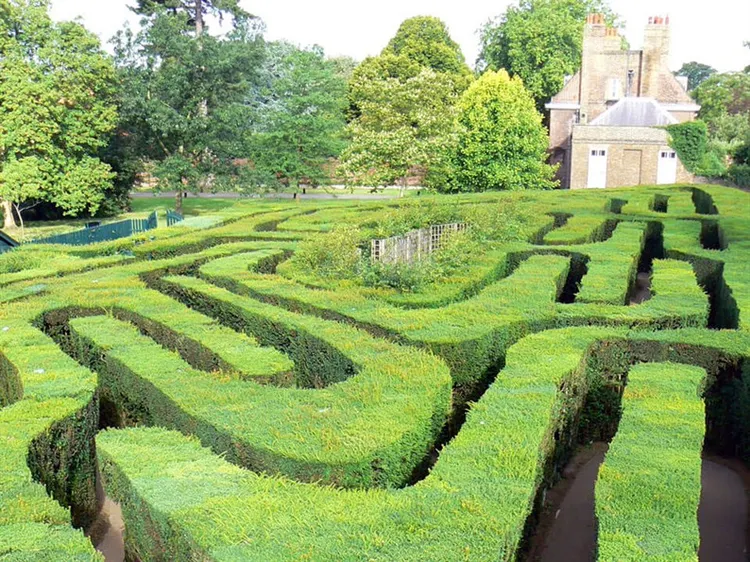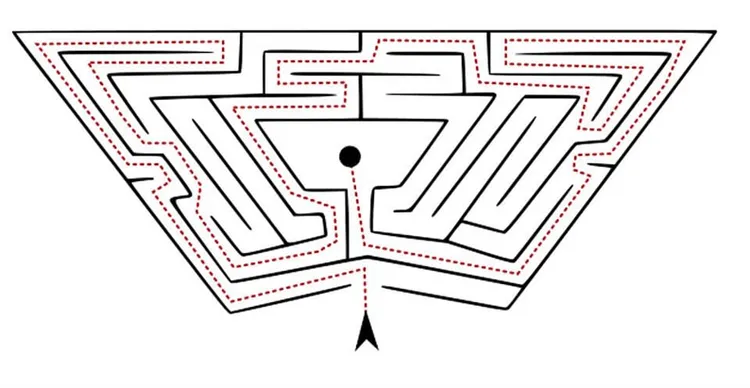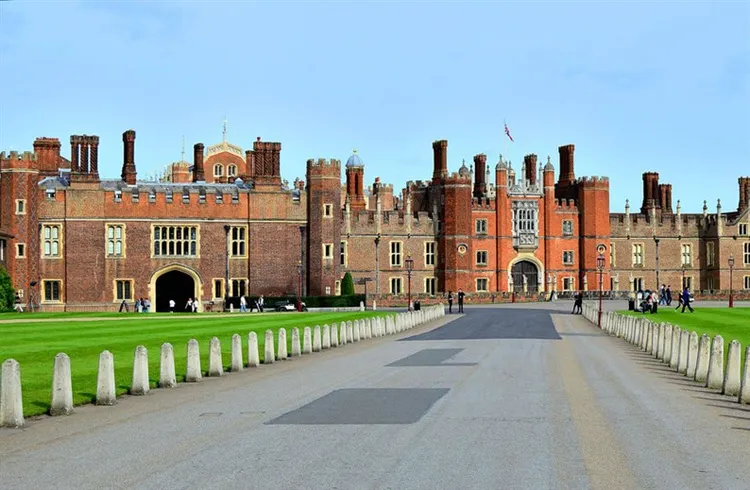Hampton Court in London – history, photo, description, opening hours, map
Despite the fact that the prelates of the Roman Catholic Church took a vow of material poverty, Cardinal Thomas Wolsey built the Hampton Court residence in London defiantly luxurious. The palace was in no way inferior to royal castles. The building is perfectly preserved, and today tourists can enjoy the beauty of the complex.
Construction history
The palace was built by the Archbishop of York, Thomas Wolsey, in the early 16th century. In 1514, the prelate bought a plot of land on the banks of the Thames from the Order of the Hospitallers. Construction began in 1515 and ended in 1525. The ensemble was created by architects from Italy, they also chose a style: a combination of Gothic and Renaissance. The purpose of the complex is the personal residence of the cardinal. But soon Wolsey was forced to donate the palace to the second Tudor king, Henry VIII. This is a gift with meaning: the archbishop hoped to improve relations with the authorities.
But the attempt was in vain: by order of the king, Wolsey was arrested, and soon he died in prison. The residence remained in the ownership of the English crown. Henry VIII immediately moved his residence to Hampton Court. She remained there until the 18th century. The king improved the interior decoration of the premises: he supplemented the archbishop's collection of tapestries from 600 pieces to 2000. The chambers of the castle were replanned by order of the new owner: the Main Guard Room was placed in front of the private chambers. The guards were on duty here, the petitioners were waiting for the appointed audience. But the architectural styles were preserved.
In the 17th century, the complex experienced a second birth: William III of Orange and his wife Mary II became its owners. During their reign, the second part of the ensemble was rebuilt. The architect Christopher Wren was invited to carry out the work. This part of the complex is characterized by baroque. Wilhelm and Mary wanted to turn the ensemble on the banks of the Thames into a kind of Versailles. They set up a regular park, arranged a labyrinth. The interiors of the palace were updated. But in 1694 Queen Mary died. Saddened, Wilhelm lost interest in the complex and stopped work.
The last monarch to have a residence at Hampton Court was George II. He updated the interiors of the palace, completed the layout of the park. After his death in 1760 the ensemble fell into disrepair. In the 19th century, by order of Queen Victoria, the complex was restored and made open to the public. It was administered by the British government. From 1998 to the present, the Historic Royal Palaces Foundation has been responsible for maintaining the ensemble.
Henry VIII and his family
Henry VIII is the second king of the new Tudor dynasty. It was founded after the end of the war with the Scarlet and White Roses by Henry VII (a supporter of the Scarlet Rose dynasty) and Elizabeth of York (a representative of the White Rose dynasty). The Tudor dynastic flower was the scarlet rose, which has a white center.
Second Tudor King
Henry VIII began to rule the country at the age of 18. He had an intemperate disposition, which was combined with love. At that time England was a Catholic country. But such a religion did not allow the king to divorce his annoying wife, Catherine of Aragon. Bishop Wolsey could help (divorce in the royal families at that time met), but he did not want to bother the Pope about this delicate matter.
This is what put an end to the once warm relations between the prelate and the monarch. Wolsey was arrested, but Henry founded a new church (Anglican), and appointed himself head. Such a demarche would not have been possible if dissatisfaction with Rome had not accumulated in the society of that time. But Henry finally believed that he was above the power of heaven. Such impunity did not pass without a trace: his vices flourished.
Bluebeard's Wives
King Bluebeard has acquired the sad habit of marrying:
- After the divorce, he immediately married Anne Boleyn. The marriage turned out to be short-lived: after 3 years, Henry got tired of his wife. He accused her of infidelity, and for clarity, executed. In addition, he was already infatuated with Anna's favorite, Jane Seymour. From a short marriage there was a daughter, who later became Queen Elizabeth 1.
- Bluebeard was not alone for long. Another wife, Jane Seymour, gave him a son (later King Edward VI). But the queen died in childbirth.
- The widower was shown a portrait of Anna of Klevskaya. The king liked the image and he decided to marry again. But the original disappointed Heinrich, and for good reason. The court painter did not personally meet Anna, he used the already existing ceremonial portrait. Most likely, both painters embellished the original. For political reasons, they still had to marry. And if the wife is not nice, then you can get a divorce. The prudent Anna agreed to dissolve the marriage and did not lose: she received the lifelong title of “beloved sister of the king” and permission to attend all official events. The lady remained a rich bride: as a reward for her complaisant nature, she received estates and gracious permission to remarry at will. Anna didn't use it.
- Not all of Bluebeard's wives were so prudent. Catherine Howard allowed herself to continue having lovers after her marriage to the king. Naturally, the scaffold was waiting for her soon.
- The last wife of the second Tudor managed to be married twice and widowed twice. Catherine Parr survived the king and then married for the fourth time.
Three children from 6 marriages of Henry at one time ascended the royal throne: Mary I, Elizabeth I and Edward VI. Mary was nicknamed Bloody Mary because of the indomitable nature of her father she inherited. The life story of the first crowned owner of Hampton Court is painted in crimson tones. It is not surprising that the ghosts of Bluebeard's wives roam the galleries and chambers of the castle.
Palace interiors
The restoration preserved the main interiors of the castle. Tourists are invited to see:
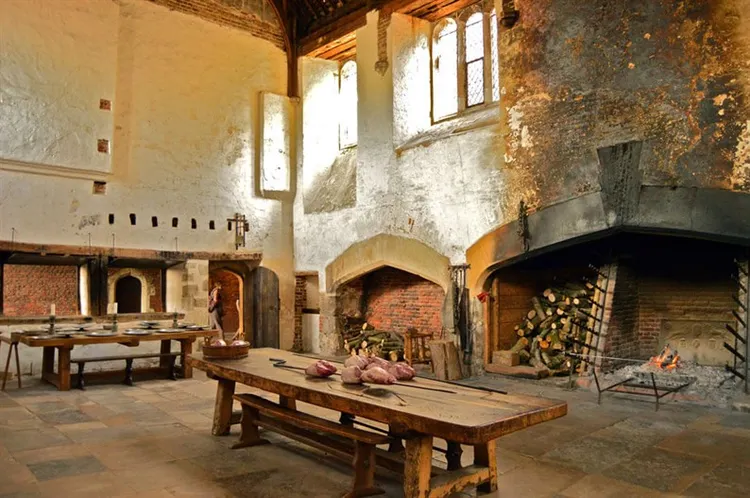 2 Royal cuisine. This room is amazing in its size. However, this is not surprising: they had to cook for a whole army of household members and guests. During the restoration, soot was preserved, which covers the wall to the ceiling near the huge stove. There are kitchen utensils, crockery, pies and bread models on the tables and shelves. The second half of the kitchen is working. Here, chefs dressed in costumes prepare dishes from the time of Henry Tudor and share recipes with those who wish.
2 Royal cuisine. This room is amazing in its size. However, this is not surprising: they had to cook for a whole army of household members and guests. During the restoration, soot was preserved, which covers the wall to the ceiling near the huge stove. There are kitchen utensils, crockery, pies and bread models on the tables and shelves. The second half of the kitchen is working. Here, chefs dressed in costumes prepare dishes from the time of Henry Tudor and share recipes with those who wish.
- Big hall. Bishop Wolsey did not envision the existence of this room. The hall was rebuilt for its own needs by the new owner – the king. The monarch himself and members of his family with retinue and guests dined in it. Tourists do not pass by a bay window with colored stained-glass windows. Carved wood ceilings, darkened with time, have been preserved. The interior is complemented by tapestries and hunting trophies.
- Galleries and transitions. This is a feature of medieval buildings: this way you could get to any part of the castle. Notable is the Ritual Process gallery. It got its name due to the fact that on Sundays Henry Tudor went from his private quarters to prayer (rite) in the chapel. Through the same gallery, Catherine Howard, convicted of treason, ran to the king, wanting to justify herself. But she did not run: she was intercepted by the guards. And in the narrow passage to the Great Hall, to the right of the entrance, the Tudor coat of arms is carved from stone – a rose, and to the left – grenades, the emblem of Catherine of Aragon.
- Royal quarters. They contain an excellent collection of tapestries, porcelain, paintings by Raphael, Brueghel, silverware.
- Armory. The walls are adorned with intricately intertwined blades.
- Main guard room. This place is for guards. But the courtiers and ambassadors were waiting for the appointed audience in it. The room is divided by tapestries into small sectors: it was easier to keep warm.
The palace is made of red brick, complemented by white stone. During the restoration, not a single new decorative element was added.
Coca-Cola London Eye ticket £24.30
Tower of London and Royal Treasures
ticket £26.80 Tower Bridge ticket £9.80
Westminster Abbey entrance ticket and audio guide £20
Madame Tussauds ticket – £29
St. Paul's Cathedral: Fast Track Ticket – £16
Shard Skyscraper – Entrance Ticket & Champagne – £24.95
Sculptural group “Royal animals”
It is better to start your tour of Hampton Court from the main gate. And to enter them, you need to overcome the bridge, on the sides of which there is an interesting sculptural group “Royal Beasts”. This composition was built during the reign of Henry Tudor and Queen Jane (Bluebeard's third wife). Animals display symbols of royal power, as well as personal coats of arms of the owners: the sculptures hold them in their front paws. You can look at the statues and imagine the family tree of the owners of the castle:
- Symbol of the English kingdom – Lion
- Another Lion, but already kind of Seymour
- The symbol of the kingdom is the Dragon
- Black Bull of the Clarence family
- Bull again, but already of the Beaufort family
- Lion again, Mortimer totem
- Graceful white greyhound of the Richmond family
- Domineering Dragon – Tudor coat of arms
- Slender Panther of the Seymour family
- The mythical Unicorn is also of the genus Seymour
The animals are made of white stone. This color perfectly distinguishes the sculptures against the general background of the red brick from which the complex is built. The composition is complemented by inserts and weaves on the railings of the bridge.
Interesting: The Bank of Great Britain issued silver coins that repeat the sculptural composition “Royal Beasts”. So far, the Lion of England, the Unicorn of Scotland, the Red Dragon of Wales, the Black Bull of Clarence have entered circulation.
Chimneys lined with red bricks are perfectly visible from the bridge. The bricks are stacked rather bizarrely: from such an unsuitable building material, elegant weaves and ornaments were obtained. There are a lot of pipes: this is not surprising, because it is quite difficult to heat a huge room. Each of them is special, not like the others.
Clock Court and Astronomical Clock
This courtyard was built during the reign of Henry Tudor. The watch is a multifunctional mechanism. With it, you can find out:
- Hour of the day. The outer circle is fixed and divided into 24 sectors, with the Roman numerals from 1 to 12 repeated twice.
- The second circle is mobile. From it you can find out the day, month and sign of the Zodiac. A full turnover is completed in a year.
- The next circle moves again: a full revolution per hour. It is divided into 12 sectors. Minutes are determined by it.
- The smallest circle indicates the phase of the moon. It completes a full turn in a month.
Previously, the hour was also known by the clock when the level of the Thames began to rise. True, an interesting mechanism was created on the basis of the then accepted picture of the world: the Earth is the center of the Universe, and the Sun revolves around it.
Gardens
The first owner of the castle, Cardinal Wolsey, began planning the park. But Henry Tudor created a new, author's concept. He divided the entire territory into zones, each of which had a special purpose:
- The northern part is for entertainment
- In the east it was required to hunt
- In the south there is a cozy private park. In it the kings rested from their labors
But now there is nothing left of what Heinrich arranged. William of Orange redid everything in the Baroque style. Now along the paths are orange trees planted in tubs. Citrus is the symbol of this monarch. Today, actors dressed in medieval costumes walk in a private garden to attract tourists. Henry Tudor ordered to organize two pond gardens for growing fish for the table. But over time, they stopped monitoring the reservoirs, they began to turn into swamps. Queen Mary II was outraged by the unpleasant smell, ordered the ponds to be filled in and laid out lawns in their place.
A grape bush planted in 1768 grows in a separate greenhouse. The length of the main vine is 36 meters. But tourists are not allowed to enter the greenhouse. The pyramidal cypresses are unique. They are unusually tall. This happened because the trees had not been looked after for many years. Then they began to cut the already grown ones. Today, the gardens host the annual Hampton Court Flower Show. Professional designers in all flowerbeds present author's compositions.
How to get out of the maze
This question worried three friends traveling in the same boat with a dog. As you know, they did not manage to get out of the labyrinth on their own, despite the fact that one of them perfectly identified all the cardinal points. I had to turn to the help of a dog. Looking at a photo of neat galleries made of yew, it becomes incomprehensible: what, in fact, is the difficulty? The alleys are transparent and well lit. At the entrance, a detailed plan of the labyrinth is offered. Just look and navigate the area.
But it's not so simple. Some tourists recommend moving along the alleys according to the rule: on the left side, choose turns to the right, and on the right – to the left. Then there is an opportunity to go to the center of the labyrinth and return back to a single dead end. Some difficulty arises: after several perfect turns, how to determine in which part (left or right) the traveler is now standing?
Without a special palette and compass, the problem is unsolvable. So, the hero of Jerome was right, who argued that the main thing is to determine the cardinal points. Of course, if a tourist accidentally turned out to be a master of sports in orienteering and guessed to take all the attributes with him, then traveling through the famous labyrinth will turn out to be child's play. But there are few such people.
One visitor to the alleys, who wandered there for a long time, gave sound advice: it is worth sticking to the chosen direction of movement and turns once and for all, and then, sooner or later, the way back will be found!
Opening hours and ticket prices
From April to October, the museum is open from 10 am to 6 pm. From November to March, tourists can visit the complex from 10 am to half past five in the evening. You can buy an adult ticket at the box office for £25. This amount includes a voluntary donation (10% of the price). But if you want to save money, you can buy a ticket without a 10% surcharge. At the box office, they will definitely offer you an expensive ticket first and ask if you agree to make a donation.
With this ticket, you can walk around the castle all day and see all the expositions. For a small visitor, the price will be half: 12.5 pounds. Separately, you can purchase a ticket to enter the labyrinth. Its price is 4 pounds sterling. But he does not give the right to visit the main territory. Another way to save money is to buy tickets online. For an adult, it will be 21.2 pounds, and for a child – 10.6.
Where is it located and how to get there
Hamton Court is easily accessible by bus. But it is more interesting to come there by train, which leaves from Waterloo Station. How to proceed:
- Buy a round-trip ticket to Hampton Court at the box office, that is, return. It is important to remember: when buying a ticket after half past ten in the morning on weekdays (during off-peak hours), it costs less: 12 pounds sterling. The ticket will also be valid during rush hour, you will not have to pay extra. Saturday and Sunday are preferable to visit the complex: on these days, any time outside of peak hours.
- There will be no problems waiting for the train: trains to Hampton Court leave 2 times an hour.
- Go to the central board and find out from which platform the train leaves. Before departure, information will appear on the scoreboard through which turnstile (out of 18 available) to enter the platform.
- Be sure to validate the purchased ticket. You also need to save the return ticket. Upon returning to Waterloo, it needs to be punched again and exit through the turnstile.
- Travel time will be just over 30 minutes. Hampton Cross is the terminus of the train. When exiting the station, you do not need to validate the return ticket.
- In order to accurately calculate the return time, you should take the free train schedule in the ticket office.
- Immediately at the exit is a sign with a sign: Hampton Court. You should move on the right side. Behind the bridge over the Thames is the complex.
The entrance gates are remarkable: they are girded with golden ribbons. This is a tribute to the 500th anniversary of the castle.
